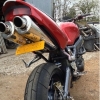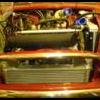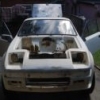
Carbon Fibre Pushrods
#1

Posted 14 January 2009 - 06:54 PM
Does anyone know anything of these pushrods? or is this a rare piece of memorabilia that is best left on the bench as a decoration?
#2

Posted 14 January 2009 - 07:07 PM
#3

Posted 14 January 2009 - 07:41 PM
Leave them on the bench, not worth the agro
Paul
#4

Posted 14 January 2009 - 08:55 PM
Although there has been a carbon-fibre push rod available for sometime, it is in 5/16" diameter. This somewhat over-engineered size meant that awkward and time consuming alterations to cylinder block and head had to carried out so that they can be a) fitted, and b) work without breakage caused be rubbing. Basically a good idea, but little consideration to fitment, and seemingly no R & D. The number of inquiries we have about the use and fitment of carbon-fibre push rods has been steadily increasing, however sales were limited because of fitting hassles. This prompted us into looking into just why 5/16" diameter rod was necessary, bearing in mind the standard steel item is only 1/4". Somewhat strange as carbon-fibre is known to be stronger size for size than steel.
To cut a long story short, a special jig was made to assess the strength of the standard and 5/16" carbon-fibre rods. We then made a one off push rod in 1/4" carbon-fibre. This was duly tested to be exactly what we wanted. It was one and a half times as strong and exactly half the weight of the standard item, yet would fit without ANY block or head modifications whatsoever. A far better product than standard, and a more sensibly dimensioned item than those previously available.
Extra benefits of a carbon-fibre push rod aside from its extra strength and super light weight, are its massively reduced expansion when hot AND almost total absence of resonance. The two latter benefits apply acutely to modern emission standards for modified road vehicles. Tighter valve clearances can be maintained to help reduce emissions. Carbon-fibre does not resonate, so valve train noise is reduced. In fact when in conjunction with our bushed, alloy, roller tip rockers and an alloy rocker cover - valve train noise is significantly reduced.
Thats from mini-mania
#5

Posted 14 January 2009 - 10:45 PM
#6

Posted 15 January 2009 - 05:39 PM
#7

Posted 15 January 2009 - 05:46 PM
#8

Posted 19 August 2013 - 05:50 PM
#9

Posted 19 August 2013 - 05:53 PM
Mini Sport use to sell them years ago about 1999-2000
Nearly as old as this thread then
#10

Posted 19 August 2013 - 07:16 PM
It is doubtful if any change will be noticed on an engine pulling less than about 7000 rpm and using a really 'wild' cam.
#11

Posted 19 August 2013 - 07:28 PM
A late friend of mine had a set in his MED 1380 back in about 2000. We actually ran a book on him breaking down on the Riviera Run that year, which he did, of course. The cause? Shattered carbon fibre pushrod. I think they're a bit of gimmick. "F1 teams use CF therefore they're cool and I must get a set" type of mentality.
#12

Posted 19 August 2013 - 07:40 PM
My son worked on a Bentley Turbo engine design and they would not use CF because they were unsure of it's capability in such an application even though they were desperate to get the valve train inertia down.
Titanium or high-grade aluminium alloy rods might be a better and safer option if valve train inertia is an issue. If not, stick with the reliable steel ones.
#13

Posted 19 August 2013 - 08:18 PM
Ian at green and white said this about them.
If a carbon one breaks you will not finish a race.
you will not break a steel one, you may bend one but you will finish the race and a replacement is £2 ish.
makes sence to me
standard stuff is tried and tested.
why fix what isnt broken???
over the last ten years racing A series I really do question some of the performance parts that keep on appearing on the market.
#14

Posted 19 August 2013 - 08:26 PM
#15

Posted 20 August 2013 - 08:21 AM
Rather than fitting CF push rods, you would be better off lightening the valve train by addressing the rocker weight by using forged steel rockers lightened and polished and lightening the cam followers using the accepted techniques for doing this. it really is not necessary below about 7000 rpm, but a lighter valve train does mean a lighter valve spring can be fitted, so long as you know how to calculate this.
CF pushrods don't gain you power, they just allow higher revs. Howe many of us are going to rev to 7500 to 8500 rpm - only race drivers I guess.
1 user(s) are reading this topic
0 members, 1 guests, 0 anonymous users
























